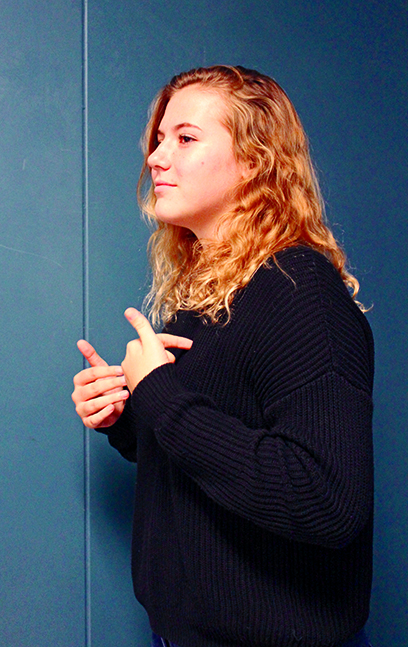Satisfaction of speaking a language unspoken
SIGNING TO A FRIEND: Freshman Kate Scarboro has been using sign language to communicate with her family members since she was little. Kate enjoys being able to showcase part of her family’s culture in such a public way on a daily basis.
January 1, 2018
German, Russian, French, English. There are many languages spoken all over the world by billions of people with unique cultures. Yet, there is still a lack of understanding to individuals within these cultures. But who says a language needs to be spoken or even heard?
Freshman Kate Scarboro is bilingual in English and in American Sign Language (ASL) due to her mother and brother both being deaf.
“I do consider myself bilingual as the rules for ASL are much different than English,” Scarboro said. “I have those moments where I catch myself signing as I’m talking without realizing it, or I’ll ask my friends for something in ASL because I can’t remember the English word.”
Scarboro has embraced both languages since she was a little girl and continues to as she has gotten older.
“I was taught sign language growing up as I learned English, and I don’t really consider one or the other to be my first or second language, because the only difference to me is that one is heard and the other is seen,” Scarboro said. “My brother, who is deaf, is only a year older than me so when he was being taught to sign, I was there right alongside him.”
Not many people understand the full extent of what it means to be deaf. It is a culture within itself, therefore has its own language as others do. Kate’s mother, Megan Scarboro, gets a lot of mixed reactions in response to being deaf and having to use sign as means to communication.
“When people say ‘Oh, I’m sorry’ when they realize I am deaf, I’m not offended at all. It just tells me that they aren’t knowledgeable about deaf culture,” Megan said. “I’m more than happy to explain that there is nothing to be sorry about it. I’ve never known what it was like to be able to hear so I don’t know what I’m missing out on. I’m just happy with the way I am.”
Deaf individuals are often pitied out of misunderstanding, believing the culture to be a disability when in reality it is just as normal to speak through sign as any other language but the Scarboro family is working to undermined those stereotypes about the deaf community.
“It’s a really common thing where I tell people my mom is deaf and they apologize because they don’t know how to react,” Kate said. “It puts me off when people apologize since being deaf is in no way a liability and that the culture and the people are just really amazing and accepting, so when people apologize it makes being deaf or having a deaf parent sound like a bad thing, when I wouldn’t have it any other way.”
Learning sign at a young age is the same if not easier as learning it when you are an adult as Kate has learned from first hand experience.
“I learned sign language in preschool when I was three years old. My parents tried the spoken language approach but realized that I was picking up language faster via sign language so they shifted over to sign language as my primary mode of communication. I have been using it ever since,” Megan said .
Some people, such as Kate’s friend freshman Maria Rene San Esteban, see sign language as a way to express themselves in a different way that is no different than other languages.
“I think everybody should learn sign because at one point or another you’re gonna run into someone that can’t hear and it’s so simple to learn sign language,” San Esteban said. “It’s simple and easy and that way we could have less language barriers around the world.”
In and outside of school, Kate is treated as every other student or teen is in reaction to using sign as a means of communication.
“Nothing really changes at school other than me being aware of other kids at Bowie and having really close relationships with some of them,” Kate said. “But in real life it really just made me connections with people all over the country and world who I wouldn’t have had if I didn’t know sign language, which I’m really grateful for.”
Kate and her family feel at home in Austin, a community with many deaf individuals that have welcomed the family with open arms.
“I definitely encourage everyone to learn sign language especially here in Austin as there is large deaf community here,” Megan said. “I would love to see Bowie set up a sign language class as many colleges do accept sign language as a foreign language requirement.”
Kate’s friends also recognize that learning sign isn’t that difficult and that anyone can learn.
“If there’s one language that everyone could learn it would be sign language because you don’t need to learn to write or grammar rules or stuff like that,” San Esteban said.
Even though one might not need to know sign language on a day to day basis it can be helpful in certain situations.
“At some point you’re gonna run into someone who can’t hear and it’s way easier for them if you know how to talk to them. Also it’s fun,” San Esteban said.
Learning sign language can be as easy as signing up for a club provide by students at school.
“I learned sign language at Gorzycki’s sign language club because Kate took me with her. Since she speaks sign language she liked going to help out so she took me with her and I learned the alphabet and a couple of words,” San Esteban said.
Kate has lived her life audibly and non-audibly speaking the languages of the cultures she is interwoven with.
“Knowing sign language is incredibly useful, and it helps me meet new people and make new connections all the time,” Kate said. “It also really helps out when I need to interpret for my mom when we’re out doing things together or if she’s talking to a hearing person and they don’t understand what she said”.
Kate is passionate about the deaf community and encourages all who want to communicate whether they can hear or not to learn ASL.
“It would be really great if more people learned sign language, especially since the deaf community is one of the largest I’ve seen in the country,” Kate said. “People would get to see what I get to see on a daily basis, and they’d see a tight knit group of passionate people who are proud of who they are.”










